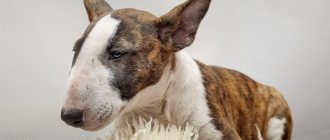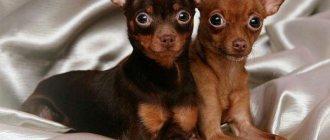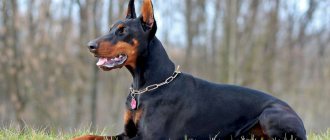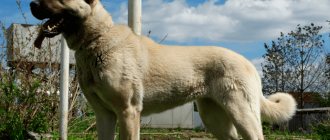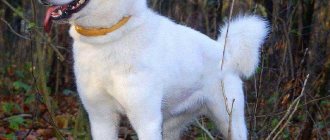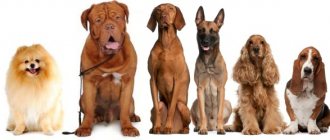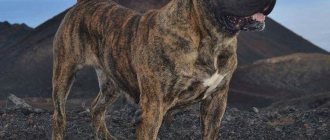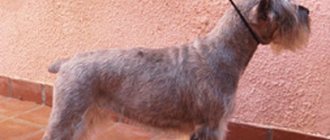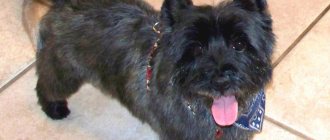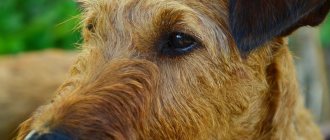Just a few decades ago, the Sealyham Terrier was a popular breed only in England, which is the birthplace of this breed.
But today these dogs are well known all over the world. In Russia they are also not spared, but so far officially there are a little more than a hundred of these dogs in the country.
Positive, kind, loyal and friendly pets have captivated both beginners and experienced breeders.
The owners of these dogs are many media personalities: Alfred Hitchcock, Elizabeth Taylor, Jean Harlow, as well as representatives of the royal family of England.
History of the Sealyham Terrier breed
It is easy to make friends with these animals due to their wonderful character, they get along especially well with children, but caring and raising Sealyham Terriers has its own subtleties.
Previously, this breed was considered a hunting breed. They hunted fox, badger and otter with dogs. Now Sealyham Terriers are exclusively decorative pets, friendly, who are strongly attached to the family and happily play with children. They are quite loyal to other pets in the house.
The breed originates from Wales, UK. In this place, the main industry was hunting and maritime trade, since the territory had access to the sea and was all covered with reservoirs.
Commoners could not afford to keep large dogs, which is why dogs like terriers gradually began to appear. They were intended to protect homes and food from small pests such as rats. However, the characteristics of dogs were not limited to this. Their main purpose was to hunt burrowing animals.
The breed originated in Great Britain, in Wales. They lived here mainly by hunting and maritime trade, which was due to access to the sea and a large number of reservoirs. The middle and lower classes did not have the opportunity to keep large dogs, which is why pets like terriers began to appear. They protected houses and food supplies from small pests such as rats. But the characteristics of the dogs did not end there, and their main purpose for keeping them was burrow hunting.
Sealyham Terriers were bred in England in the 1850s by the owner of the Sealy Hem estate, George Tucker Edwards. He was a retired captain who was interested in hunting. This is how he came up with the idea of breeding a breeding population of brave and strong dogs with good reactions and powerful jaws.
Most likely, the following breeds were used for selection:
- Dandy Diamond Terrier (had a strong jaw and a reliable skull)
- West Highland White Terrier (Sealyham Terriers now have their size and coat color)
- Dwarf White Bull Terrier (also conveyed its color, as well as courage, power and agility)
- Pembroke Welsh Corgi (have the same length of body and legs as Sealyham Terriers)
The selection of puppies during breeding was quite strict. What was needed were rather vicious dogs, which were initially set on rats and mice, and then ferrets. Upon reaching the age of six months, the most resilient and strong pets were selected from the babies, the rest were sent for culling. Those who remained were trained in hunting, in which the animals had to boldly enter a hole, and, based on the results of “internal competitions,” they were left to breed the best of the best. The breeder himself excluded bullies and fighters from these competitions, as a result of which the Sealyham Terriers have a friendly and good-natured character.
Already under Edwards, Sealyham Terriers began to become popular in England. They were valued for their ability to excellently fight prey both in burrows and on the water. The beautiful appearance of the pets was also appreciated, and as a result, breeders appeared whose activities were aimed at improving the appearance of the breed. One of these breeders was Edwards’ daughter Victoria, who continued her father’s work.
The first participation of Sealyham Terriers in an exhibition took place in 1903, in Wales. Five years later, a club was created in which a breed standard was developed and approved. When this happened, Sealyham Terriers began to be bred not only for hunting, but also as companion animals.
REFERENCE! The Sealyham Terrier breed was officially recognized in 1911. The introduction to the international standard took place already in 1954.
Characteristics and standard
The Fédération Cynologique Internationale (FCI) classifies the Sealyham Terrier as a Spitz breed. According to the standards, representatives of this variety of small terriers were previously widely used as hunting dogs. However, today it is a purely decorative breed of dog. They are bred to participate in exhibitions and as pets.
According to the opinions of professional dog breeders, the Sealyham Terrier breed is a hardy and very brave dog, distinguished by fearlessness and agility. The dog is friendly towards children, but can fight back if a child hurts him (for example, hits him or pulls his fur).
Description of the Sealyham Terrier breed
- According to the FCI classification, the breed has number 74.
- In terms of height, Sealyham Terriers are not divided into males and females. The average is 30-31 cm.
- As for weight, males weigh up to 9 kg, and females - from 7.8 kg to 8.2 kg.
- Head: has a wide convex skull, almost flat in the face area.
- Muzzle: Rectangular in shape, with powerful square jaws.
- Nose: black, small and mobile.
- Eyes: have dense eyelids, a rounded cut, the color of the iris is brown or black. Planted at a medium depth, slightly recessed into the skull. This way they are more protected when the terrier fights with the beast.
- Cheekbones: quite wide, but not protruding, smoothed.
- Teeth: large, jaws have a scissor-like closure.
- Ears: Medium size, erect, triangle-shaped with rounded tips. There is a fracture at the bottom of the cartilage, and at rest the ears are almost adjacent to the head and are in a lowered state. Located on the sides.
- Neck: strong, developed and long, with pronounced withers.
- Body: elongated, very flexible, with a wide and deep chest.
- Back and loin: with straight posture, flexible and medium in length, sloping croup.
- Paws: powerful and short, the hind legs are stronger than the front ones.
- Tail: carried in a vertical direction. Short, but can be stopped.
- In size, Sealyham Terriers are small dogs, but they are physically strong, energetic, and have an excellent hunting instinct.
- Coat: hard, medium length. The undercoat is dense, as a result of which the skin is protected from the penetration of moisture and wind. It has no tendency to shed, often does not cause allergies even among allergy sufferers, and is odorless.
- Color: white, with possible spots of different colors - cream, fawn, gray-blue, brown, zone-mixed. Black markings are acceptable but not desirable.
Appearance
The official description of the breed presents the Czech Terrier as a comfortable dog in every sense. These unusual, short-legged dogs are successfully trained to work, and their physique is only a plus for hunting in a hole. Short legs do not in any way affect the physical strength and anger of the Czech Terrier, therefore, if necessary, he is trained to work on the ground (badger, fox).
Visually, females are a little more refined and elongated than males, but this difference does not affect physical strength and strength. Males are distinguishable by their muzzle and look. The dimensions of dogs vary within the same limits regardless of gender:
- Height: 27–30 cm.
- Weight: 6–9 kg.
Convenience in the compactness and versatility of the breed. According to the standard, the Czech Terrier is a small pet, agile, active, persistent, but not wasting energy. Despite the stockiness, the body composition is very harmonious and proportional, with the exception of height.
Breed standard
The head is rectangular, the muzzle is wedge-shaped, the silhouette is emphasized by a beard and eyebrows, the back of the head is convex. The forehead is not wide, almost flat, slightly tapering. The transition is marked and divided by a groove. The bridge of the nose is elongated and smooth. The brow ridges are not clearly expressed, but are emphasized by the coat. The cheekbones are developed and fit harmoniously into the silhouette. Both jaws are fully developed, moderately wide and strong. The lips are not dry, but elastic and not saggy.
The teeth are large, in the correct bite, the incisors are in line.
Nose – black, brown or light brown, proportional.
The eyes are small, blue set, well covered with eyebrows. The look is measured, not defiant, attentive. The color of the irises ranges from rich brown to light hazel depending on the coat color. The eyelids are tight-fitting, dry, colored to match the nose.
The ears are triangular, medium-sized, set high, lowered to the head. Movable on cartilage, refracted in the first third. The rounded tips of the ears are adjacent to the cheekbones, the auricle is completely covered.
The body is strongly built and squat. The neck is of proportional length, wide, oval, set harmoniously at an angle of 45°, the scruff is not pronounced, there are no folds, although the skin is not dry. The body is not too long, proportional, the back is straight and wide, the withers are powerful. The chest is oval, well elongated, voluminous, descending to the elbows or slightly below. The ribs are rounded, easily palpable, extended towards the groins. The loin is very muscular, the croup is very strong, neat, sloping. The belly is not dry and should not interfere with rapid movements.
Limbs – Unlike most short-legged dogs, the Czech Terrier's limbs should be straight. When moving, the dog quickly throws out its paws, and the amplitude should not be sweeping. The front legs are straight, the bones are large, visually, the legs look powerful. The shoulder blades are pressed to the body, but are free to move, the shoulders are well muscled, the elbows do not rub against the body, they are directed strictly back, not tucked in, not turned out. The hind legs are set wider than the front legs and pulled back, the bones are powerful. The thighs are muscular, not too long. The shins are elongated, set at a harmonious angle. Due to the shortened shins, the hock joints are slightly elevated, directed only back. The hands of the front paws are larger than those of the hind paws. The paw pads are large and convex. The claws are strong, curved, pigmentation is not important, but should be in harmony with the color.
The tail is thick and long in comparison with the body. Set on almost in line with the back or slightly higher. Carries freely, in a state of excitement - above the line of the back, slightly curved.
Character traits
Sealyham Terriers have an easy-going and easygoing nature, which makes them popular as companion dogs.
They are valued for qualities such as:
- Kindness and good nature
- Loyalty and devotion
- Peacefulness and tranquility
- Lack of aggressive attitude towards other breeds and brothers
- Courage and agility
- Playful disposition
- Love for young children and the elderly
- Unobtrusiveness. The dog will not bother you if he sees that you are busy, he will find other entertainment
- Does not require intense physical activity or long walks
- Average aptitude for training. If the dog does not want to follow certain commands, it is impossible to force him
- They have sufficient intelligence, but with high activity and playfulness they do not notice the owner’s commands
- He performs well as a watchman, as he can loudly notify his owners about the appearance of a stranger, but he is unlikely to be able to cope with him, so he is a weak guard
- Sealyhams love agility training (obstacle courses)
Maintenance and care
The dog can be kept both within the walls of a city apartment and in a private spacious house. Due to their small size, sealyhams are quite unpretentious. But prolonged and loud barking can displease neighbors. Therefore, a private house still remains the best option.
IMPORTANT! Sealyham Terriers cannot be kept in an enclosure; they must live exclusively close to their owner and family.
If this is not possible, two hour-long walks a day can be compensated for by one two-hour walk, but it must be active, with games and training. In the summer, walks should be minimal, as pets do not tolerate heat very well. Fatigue during these periods increases sharply, and playfulness decreases.
The following care is also required:
- Wool: Although the animal does not shed, it needs to be combed with a special brush. Bathing should take place monthly; if it is heavily soiled, it can be done more often.
IMPORTANT! Dogs are quite susceptible to allergies, so you need to carefully choose a shampoo.
- Teeth: brushing should be done 1-2 times a week. You need to get used to this from puppyhood.
- Claws: most often, the dog grinds them down naturally. But periodically it is necessary to adjust the length of the claws using a nail clipper.
- Ears: Pets are practically not susceptible to otitis media. But for prevention purposes, it is recommended to do regular examinations and clean the ears every two to three weeks.
- Eyes: Sealyham Terriers are susceptible to eye diseases, so they need regular examination of the eyelids, mucous membranes and irises; it is also recommended to visit a specialist to assess the pet’s condition, and at home, wash the eyes with a weak chamomile decoction every 4-7 days.
- Trimming (hair plucking) : this also needs to be done 1-2 times a week. This procedure prevents the formation of tangles and gives the pet an aesthetic appearance, because due to the lack of shedding, old hairs do not fall out. If the owner has not done this kind of work before, then it is better to entrust it to the master. Grooming the dog is not recommended. This is fraught with changes in the coat structure, as a result - it becomes very brittle and too soft. It is only allowed to shorten the beard and cut off excess hair between the fingers. It is also recommended to remove excess tail hair weekly.
ATTENTION! Your pet's beard should be cleaned after every meal.
A daily light massage of the withers will be beneficial for the dog. Timely deworming, vaccination and preventive appointments with a specialist have also not been canceled.
Nutrition
Nutrition is extremely important to maintain your pet’s tone, cheerfulness, health and beauty.
The following rules must be followed:
- Feeding should be done with hypoallergenic food of exceptionally high quality (preferably holistic, grain-free or rice-based).
- Monitor the nutritional value and balance of food (it must contain the required amount of proteins, fats, carbohydrates, vitamins and minerals)
- It is necessary to gradually introduce fresh lean meat (pork is strictly prohibited), cereals, cottage cheese and vegetables into the diet, supplementing the main food with these products.
- Feed only 2 times a day without snacks the rest of the time.
- It is important to keep food calories and portion size under control, as Sealyhams are prone to obesity.
It is prohibited to give such products as:
- Fish. It can provoke the appearance of parasites in the dog’s body, as well as cause vomiting and diarrhea.
- Bones. They are harmful to the dog’s stomach and lead to kidney stones.
- Potato. It is not absorbed by the body, is harmful to digestion, and can cause diarrhea.
- Dairy products. Causes diarrhea and bloating in the pet.
- Yeast dough. Leads to rupture of the stomach and intestines.
- Sweets. Foods containing too much glucose can cause diabetes and lead to tooth loss.
What to feed?
Sealyham Terriers are unpretentious in their diet, but there are certain points that are worth remembering. The animal should receive high-quality hypoallergenic food, allowing it to replenish energy reserves throughout the day. If you choose a ready-made diet, you should give preference to holistic food without grain additives or based on rice.
Natural nutrition is also acceptable. It is recommended to combine lean meats, vegetables, oatmeal or rice in your diet. To replenish calcium reserves, dogs are given cottage cheese. The optimal feeding regimen is twice a day, without additional treats during the day. Due to the tendency to overeat, Sealyhams' nutrition has to be controlled quite strictly. The dog's diet should not contain fish - it causes stomach upset in representatives of the breed. Bones are also excluded, as they provoke the formation of kidney stones and injure the stomach and esophagus.
Health and life expectancy
Sealyham Terriers are in excellent health. They have an excellent immune system, good tolerance to low temperatures and difficult physical training. But, unfortunately, there are diseases that pose a risk area for these dogs.
Such diseases will include:
- Ophthalmological diseases. More often observed in elderly pets. They are often diagnosed with cataracts, retinal atrophy, glaucoma and lens displacement.
- Allergic reactions and intolerances. This also includes a fairly pronounced reaction to flea bites. It is important to pay special attention to the issue of treating fur from various insects, as well as build a diet on balanced and hypoallergenic food.
- Congenital deafness. Sealyham Terriers are genetically predisposed to this disease due to their white coat.
- As previously mentioned, dogs are prone to obesity. If it is already manifested in your pet, do not try to starve it. You need to consult a veterinarian and choose the right low-calorie diet.
With proper and good care, these dogs can live 12-15 years, and long-livers who live up to 17 years are becoming common.
Where to buy a rabbit fur coat
- Sheared rabbit fur coats. This fur coat is similar to velvet or silk, which perfectly warms even in winter frosts. This outerwear is of good quality and special beauty. With good care, the fur coat will last for quite a long time.
- Rex rabbit fur coats. The products are in demand because their fur is smooth, thick and very soft. This type of outerwear has a combined color, for example, a dark back and white sides, which perfectly masks various figure flaws. In addition, there are snow-white models, as well as options made in one tone.
- Dyed rabbit fur coats. Fashionistas can afford to buy coats made of dyed fur, thereby replenishing their wardrobe with interesting models. Moreover, given that the cost of fur coats is not expensive, you can purchase several models for different occasions. A short version of a fur jacket is suitable for everyday wear. For a more festive occasion, you can buy a long rabbit fur coat to wear over a beautiful dress.
The price and quality of rabbit fur coats are comparable. Even if the fur coat will last only 2-3 seasons, the low cost will allow you to buy a completely new fashionable model from the latest collections.
How to choose a puppy
Before choosing a Sealyham Terrier puppy, it is important to decide on the purpose of purchasing it: for an exhibition or as a companion dog.
But in both cases, pay attention to the condition of the puppy and indicators such as:
- Energy and activity. The baby should be playful, cheerful and cheerful; the opposite behavior may indicate some kind of illness.
- Appetite. Sealyham Terriers love to eat, so a puppy's refusal to eat is a red flag.
- Eyes, ears and nose. A healthy baby's eyes should shine, his ears should be clean, and his nose should be moist and cool.
- Teeth . Small fangs should be strong and white.
- Wool. The coat should be shiny, clean and well-groomed.
It is recommended to take animals from nurseries with a decent reputation, since a dog purchased at a poultry market or from an unreliable breeder may be sick or not purebred.
Appearance
The Sealyham Terrier and Scotch Terrier gave rise to another breed of dog - the Czech Terrier. The skull is slightly convex, wide between the ears. The muzzle is square, long, powerful, with a heavy jaw. The nose is black. The teeth are straight, strong, scissor bite. Cheekbones are not protruding. The eyes are deep-set, round, medium in size, dark in color. The ears are medium sized, rounded at the tips, and hang loosely close to the cheekbones.
The neck is long, muscular and thick. The body is flexible, of medium length. The back is strong and straight. The chest is deep and wide, well let down between the front legs. The ribs are well sprung. The tail is set high and carried vertically. Can be docked to medium length, thick, with a rounded tip. In its natural state, the tail is thick at the base, tapering towards the tip, and of medium length.
The Sealyham Terrier is a short, strong dog. The head is long and wide, in proportion to the body. The skull is slightly convex with a slight offset between the eyebrows and a moderate stop. The nose is black with large nostrils. The teeth meet in a scissor bite and the jaw is square. Oval, wide-set eyes of a dark color.
The ears are wide, hanging, folded forward. The tail is set high and is usually docked. Cupping is illegal in most European countries. Double coat, top hard, white, sometimes lemon- or tan-tinged, with slight colored markings on head and ears. Height no more than 30 cm, weight maximum 9 kg. Life expectancy is about 15 years.
Sealyham Terrier
Education and training
Despite the well-developed intelligence of the Sealyham Terrier, its upbringing is not easy. Effective training requires strength of human character and patience. Therefore, it is better to entrust the training to a professional trainer.
If you decide to take your pet’s training into your own hands, you will have to follow the following rules and take into account some of the features of these dogs:
- You need to act gently, without coercion
- It is important to encourage and praise the dog and give treats as a reward for obedience.
ON A NOTE! The same type of commands can quickly get boring for your dog. Change activities often.
- It is strictly forbidden to shout at Sealyham or hit him, otherwise he will hesitate and will not respond to commands at all.
- Give the opportunity to run and chase game, because dogs of this breed really like it.
IMPORTANT! The stubbornness inherent in Sealyham Terriers can ruin an entire training session. It is necessary to show the dog at the very beginning who is the leader and leader here.
- Training in open areas requires more attention from the owner, because dogs, following the instinct of a hunter, can easily break away and run after another animal.
Start training as early as three months. By this time, the kids already know their nickname, run up to the owner’s call, and also keep order in the house. Serious training is recommended from 9-12 months; it is better learned in a playful way.
About the difficulties of training
These animals have character and are difficult to train. We need the help of professional dog handlers in order to achieve success.
Important! The Sealyham Terrier is a very good and devoted friend; he can do anything for his owner, even sacrifice his life.
But if the pet has been in your family since infancy, then you can raise it well yourself.
Before purchasing a small snow-white terrier, you need to thoroughly assess your financial, moral and physical capabilities. After all, a living puppy is not a toy and requires daily care, walks, and quality nutrition. But all your efforts are compensated by moments of happiness and joy while communicating with a new devoted friend. This dog is created for the family and will give a good mood to adults and children.
Pros and cons of Sealyham Terriers
The advantages of the breed are:
- Does not shed, does not cause allergies
- Good in the role of watchman and security guard.
- Loves children very much, you can leave her as a nanny.
- Well trained.
- Quite unpretentious in terms of care.
- Very compact in size.
- It has a pleasant and beautiful appearance.
- It is small in number, which means you rarely see similar ones in the neighboring yard.
- Brave and courageous.
- Focused primarily on people.
- Active and friendly.
The disadvantages include:
- Tends to take dominant positions over other animals and may exhibit an aggressive attitude.
- Requires constant play activities and physical exercise, as he quickly loses interest.
- It is possible to keep it in an apartment, but it is difficult because of the constant barking.
- Willful, obstinate and stubborn, it requires firmness and will from the owner during training and education.
If we look at it as a whole, this is a small but very loyal dog, a real pet, capable of pleasing and making its owner happy for many years.
Where to buy a puppy and at what cost
In Russia, Sealyham Terriers began to appear only at the end of the 19th century. Today, only in Moscow there are two largest nurseries. In addition, dogs can be found in the Volga region, in the Southern, Central regions, as well as in the Far East. The price for a Sealyham Terrier varies from $300 to $1000 (20,000-65,000 rubles)
To buy a dog in Moscow, you can contact the “Moscow National Breed Club” (website: https://sealyham-terrier.ru/). A dog for exhibitions will cost you at least 30,000 rubles. A pedigree will be provided for him, he will definitely be purebred and suitable for further breeding. It is better to contact a nursery for such puppies.
A companion dog and a pet will cost less - they can be bought for 12,000-20,000 rubles per puppy. Most often they will have some minor defects in appearance. But even in such a case, buying from someone else is not the best idea. You can turn to professional single breeders.
Here are some of the Silichim Terrier kennels (including foreign ones):
- "Bambino Di Sole" (Krasnodar, Russia);
- "Dartan Company" (Moscow, Russia);
- "Of Taita's Ushabti" (Kalbach, Germany);
- "Riziki" (Orimattila, Finland)
The Sealyham Terrier is a snow-white bundle of joy that will become a wonderful family member, he is brave and courageous, energetic and playful, and will greet you at the entrance every day with his ringing voice and joyful wagging even in the most inclement times.
Sealyham Terrier price
If your puppy is going to win titles and medals at exhibitions and various competitions, you will pay 30 thousand rubles for him. At the nursery where you buy the baby, you will be provided with a medical card and a passport as proof of his high-born origin.
If a puppy has disqualifying characteristics, you can buy it cheaper, for 20 thousand. You can buy yourself an excellent companion for 12 thousand. But try to choose a dog for yourself in nurseries or clubs. The bird market can present you with considerable surprises and problems.
Owner reviews
Vitaly: “I constantly participate in exhibitions with my Sealyham Terrier, so I provide the dog with careful care. But these pets do not cause any special problems; they tolerate procedures to maintain hygiene and health well, even aggressive ones. Besides, such a playful and cheerful dog is quite easy to keep.”
Maria: “I bought Sealyham for my sons and have no complaints about the dog. Yes, his coat sometimes causes a lot of hassle, but otherwise, the dog is simply wonderful! Children happily play with him and take long walks, the dog is very loving and friendly, treats children very well, never offends them and simply dotes on them.”
